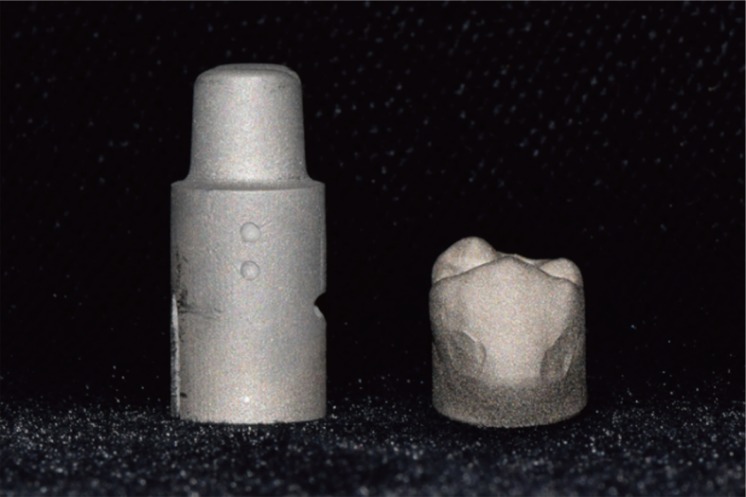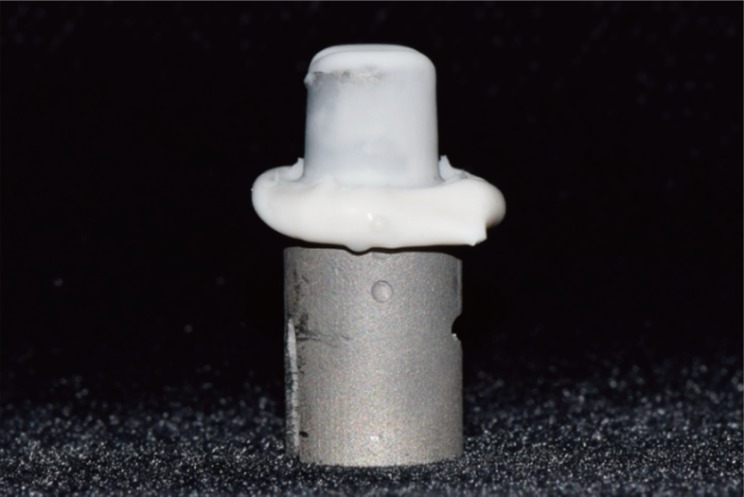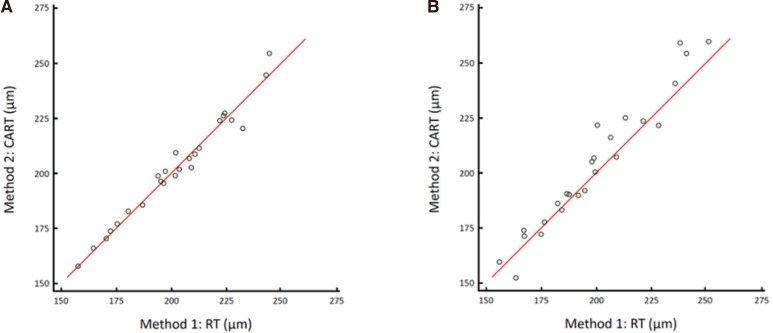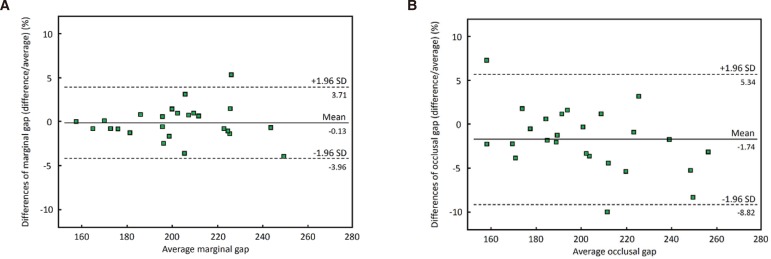J Adv Prosthodont.
2017 Oct;9(5):358-363. 10.4047/jap.2017.9.5.358.
Verification of a computer-aided replica technique for evaluating prosthesis adaptation using statistical agreement analysis
- Affiliations
-
- 1Department of Prosthodontics, School of Dentistry, Kyungpook National University, Daegu, Republic of Korea; and Department of Prosthodontics, National Hospital of Odonto-Stomatology, Hanoi, Vietnam.
- 2Department of Statistics, Kyungpook National University, Daegu, Republic of Korea.
- 3Department of Prosthodontics, School of Dentistry, A3DI, Kyungpook National University, Daegu, Republic of Korea.
- 4Department of Dentistry, Yonsei University Wonju College of Medicine, Wonju, Republic of Korea.
- 5Department of Production Engineering, School of Mechanical Engineering, Kyungpook National University, Daegu, Republic of Korea.
- 6Department of Prosthodontics, School of Dentistry, Kyungpook National University, Daegu, Republic of Korea. deweylee@knu.ac.kr
- 7Department of Oral and Maxillofacial Radiology, School of Dentistry, Kyungpook National University, Daegu, Korea.
- KMID: 2393221
- DOI: http://doi.org/10.4047/jap.2017.9.5.358
Abstract
- PURPOSE
The purpose of this study was to evaluate the reliability of computer-aided replica technique (CART) by calculating its agreement with the replica technique (RT), using statistical agreement analysis.
MATERIALS AND METHODS
A prepared metal die and a metal crown were fabricated. The gap between the restoration and abutment was replicated using silicone indicator paste (n = 25). Gap measurements differed in the control (RT) and experimental (CART) groups. In the RT group, the silicone replica was manually sectioned, and the marginal and occlusal gaps were measured using a microscope. In the CART group, the gap was digitized using optical scanning and image superimposition, and the gaps were measured using a software program. The agreement between the measurement techniques was evaluated by using the 95% Bland-Altman limits of agreement and concordance correlation coefficients (CCC). The least acceptable CCC was 0.90.
RESULTS
The RT and CART groups showed linear association, with a strong positive correlation in gap measurements, but without significant differences. The 95% limits of agreement between the paired gap measurements were 3.84% and 7.08% of the mean. The lower 95% confidence limits of CCC were 0.9676 and 0.9188 for the marginal and occlusal gap measurements, respectively, and the values were greater than the allowed limit.
CONCLUSION
The CART is a reliable digital approach for evaluating the fit accuracy of fixed dental prostheses.
Keyword
MeSH Terms
Figure
Reference
-
1. Holmes JR, Bayne SC, Holland GA, Sulik WD. Considerations in measurement of marginal fit. J Prosthet Dent. 1989; 62:405–408. PMID: 2685240.
Article2. Pimenta MA, Frasca LC, Lopes R, Rivaldo E. Evaluation of marginal and internal fit of ceramic and metallic crown copings using x-ray microtomography (micro-CT) technology. J Prosthet Dent. 2015; 114:223–228. PMID: 25882975.
Article3. Contrepois M, Soenen A, Bartala M, Laviole O. Marginal adaptation of ceramic crowns: a systematic review. J Prosthet Dent. 2013; 110:447–454. PMID: 24120071.
Article4. Boitelle P, Mawussi B, Tapie L, Fromentin O. A systematic review of CAD/CAM fit restoration evaluations. J Oral Rehabil. 2014; 41:853–874. PMID: 24952991.
Article5. Torabi K, Vojdani M, Giti R, Taghva M, Pardis S. The effect of various veneering techniques on the marginal fit of zirconia copings. J Adv Prosthodont. 2015; 7:233–239. PMID: 26140175.
Article6. Ji MK, Park JH, Park SW, Yun KD, Oh GJ, Lim HP. Evaluation of marginal fit of 2 CAD-CAM anatomic contour zirconia crown systems and lithium disilicate glass-ceramic crown. J Adv Prosthodont. 2015; 7:271–277. PMID: 26330973.
Article7. Bugurman BB, Turker SB. Clinical gap changes after porcelain firing cycles of zirconia fixed dentures. J Adv Prosthodont. 2014; 6:177–184. PMID: 25006381.
Article8. Lee WS, Kim WC, Kim HY, Kim WT, Kim JH. Evaluation of different approaches for using a laser scanner in digitization of dental impressions. J Adv Prosthodont. 2014; 6:22–29. PMID: 24605202.
Article9. Falk A, Vult von, Fransson H, Thorén MM. Reliability of the impression replica technique. Int J Prosthodont. 2015; 28:179–180. PMID: 25822305.
Article10. Laurent M, Scheer P, Dejou J, Laborde G. Clinical evaluation of the marginal fit of cast crowns-validation of the silicone replica method. J Oral Rehabil. 2008; 35:116–122. PMID: 18197844.11. Rahme HY, Tehini GE, Adib SM, Ardo AS, Rifai KT. In vitro evaluation of the “replica technique” in the measurement of the fit of Procera crowns. J Contemp Dent Pract. 2008; 9:25–32.12. Coli P, Karlsson S. Fit of a new pressure-sintered zirconium dioxide coping. Int J Prosthodont. 2004; 17:59–64. PMID: 15008234.13. Chan DC, Blackman R, Kaiser DA, Chung K. The effect of sprue design on the marginal accuracy of titanium castings. J Oral Rehabil. 1998; 25:424–429. PMID: 9687114.
Article14. Kim KB, Kim JH, Kim WC, Kim JH. Three-dimensional evaluation of gaps associated with fixed dental prostheses fabricated with new technologies. J Prosthet Dent. 2014; 112:1432–1436. PMID: 25218032.
Article15. Lee DH. Digital approach to assessing the 3-dimensional misfit of fixed dental prostheses. J Prosthet Dent. 2016; 116:836–839. PMID: 27460325.
Article16. Lin L, Hedayat AS, Sinha B, Yang M. Statistical methods in assessing agreement: Models, issues, and tools. J Am Stat Assoc. 2002; 97:257–270.17. Barnhart HX, Haber M, Song J. Overall concordance correlation coefficient for evaluating agreement among multiple observers. Biometrics. 2002; 58:1020–1027. PMID: 12495158.
Article18. Watson PF, Petrie A. Method agreement analysis: a review of correct methodology. Theriogenology. 2010; 73:1167–1179. PMID: 20138353.
Article19. Lin LI. A concordance correlation coefficient to evaluate reproducibility. Biometrics. 1989; 45:255–268. PMID: 2720055.
Article20. King TS, Chinchilli VM, Wang KL, Carrasco JL. A class of repeated measures concordance correlation coefficients. J Biopharm Stat. 2007; 17:653–672. PMID: 17613646.
Article21. Lawrence I, Lin K. Assay validation using the concordance correlation coefficient. Biometrics. 1992; 48:599–604.
Article22. Cerna M, Ferreira R, Zaror C, Navarro P, Sandoval P. Validity and reliability of the T-Scan(®) III for measuring force under laboratory conditions. J Oral Rehabil. 2015; 42:544–551. PMID: 25727489.23. King TS, Chinchilli VM. Robust estimators of the concordance correlation coefficient. J Biopharm Stat. 2001; 11:83–105. PMID: 11725932.
Article24. Vonesh EF, Chinchilli VM, Pu K. Goodness-of-fit in generalized nonlinear mixed-effects models. Biometrics. 1996; 52:572–587. PMID: 10766504.
Article25. Lopez-Suarez C, Gonzalo E, Pelaez J, Serrano B, Suarez MJ. Marginal vertical discrepancies of monolithic and veneered zirconia and metal-ceramic three-unit posterior fixed dental prostheses. Int J Prosthodont. 2016; 29:256–258. PMID: 27148985.
Article26. Kokubo Y, Nagayama Y, Tsumita M, Ohkubo C, Fukushima S, Vult von. Clinical marginal and internal gaps of In-Ceram crowns fabricated using the GN-I system. J Oral Rehabil. 2005; 32:753–758. PMID: 16159354.
Article
- Full Text Links
- Actions
-
Cited
- CITED
-
- Close
- Share
- Similar articles
-
- Evaluation of marginal and internal gap under model-free monolithic zirconia restoration fabricated by digital intraoral scanner
- Cementless Press-Fit and Fibrous or Bony Ingrowth "Asian Total Hip Prosthesis" Design Using Computed Axial Tomography and Computer Aided Design and Computer Aided
- Evaluation of the marginal and internal gap of metal-ceramic crown fabricated with a selective laser sintering technology: two- and three-dimensional replica techniques
- Reproducibility Among Residents in Evaluating Cup-disc Ratio Using Computer-aided Planimetry
- Fixed prosthesis restoration in edentulous patient fully implanted without considering definitive prosthesis: A case report







